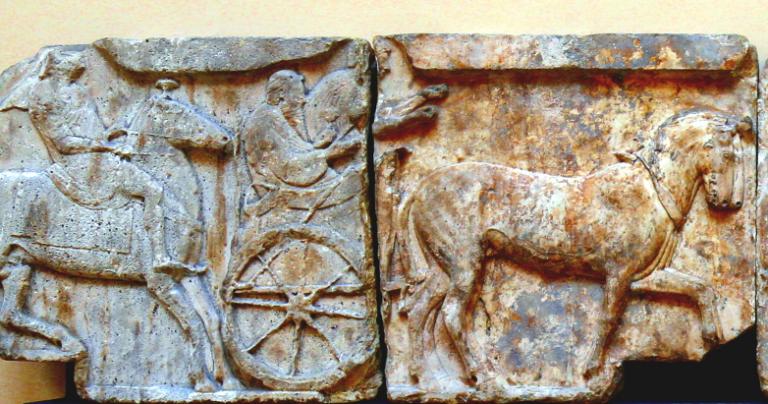I’m coming into this controversy rather late, partly due to previous writing commitments, but partly by design. I’m not in the SCA and it’s not my place to tell them how to handle their business. Most of them seem to be doing just fine dealing with a difficult situation. But there’s a secondary point here about the power of symbols and how we use them, a point that’s relevant in our wider society and especially relevant in our magic.
A brief recap for those who don’t know what I’m talking about. The SCA is the Society for Creative Anachronism. They are medieval cosplayers, re-enactors, and scholars. They’re perhaps best known for dressing up in armor and fighting with swords, but it goes far deeper than that.

Back in January, an SCA group in California held an elaborate ceremony to crown their new king and queen. The embroidery on the new royals’ costumes included swastikas and “HH” designs. When that became known a controversy ensued – the new royals issued a weak apology and later resigned. If you want more details, this article from The Public Medievalist has them, including quotes and links to other reporting.
I’ve seen many different angles on this story. Most of them deal with cluelessness (how could anybody not see how this would end up?) and insensitivity (why would you wear something you knew would offend many people, including some in your own community?). A few talk about the desire to reclaim sacred symbols (but with no idea of just how much effort and especially how much time that requires).
I want to talk about something else: symbols as distinct entities with power of their own.
Symbols have real, non-arbitrary meanings
At the most basic level, a symbol is one thing that represents another thing. Both the word “cat” and the picture below are symbols, representing a creature that lives in my house. Language itself is symbolic, with words representing objects and ideas.
Symbols are arbitrary, until they’re not. The laws of physics do not dictate that the word “cat” must be used to represent a small furry house-bound dictator. If I spoke Spanish I would say “gato” and in Greek I would say γάτα. But if I suddenly decide to call the queen of the house a raccoon, I’m only going to confuse people. Centuries of common usage have invested “cat” and “raccoon” with separate and distinct meanings.
Of course, meanings aren’t always so clear. “Cat” may mean a common house cat, but it could also mean a cheetah, a lion, or a saber-toothed tiger. If we’re discussing feline mammals over a cup of tea, the difference is important. If I tell you to watch out for the cat hiding behind the bushes, the difference is extremely important.
If I scream “but ‘cat’ is a historically accurate symbol!” while Panthera tigris tigris is eating your liver, I am at best a pedantic and self-centered person.
Symbols have lives of their own
Animism is the idea that whatever animates you and me also animates dogs and cats, flowers and trees, rivers and mountains. Animism says all these things are not things but persons with their own sovereignty and agency. It challenges us to re-examine the way we think about non-human persons and the way we relate to them.
Are symbols persons? Are they alive? That seems to be stretching the concept of animism awfully far. But how many times have we seen some thing get far from the intent of its creators and said “it took on a life of its own”?
The swastika is – as best we can tell, anyway – a human-created symbol, a representation of the sun and its life-giving rays. Its origins are in the cultures and religions of India: Hinduism, Jainism, and Buddhism. We all know what happened in the 20th century. The swastika was appropriated by the Nazis and it has been a symbol of murderous racism ever since.
What the swastika was, what it might still be in some remote village in Tibet, and what it may become at some future time when Hitler is long forgotten are all irrelevant in the face of what the swastika is here and now. The swastika has a life of its own.
The Power of Intention is real but weak
The New Age idea that “intention is everything” is 10% true and 90% marketing gimmick.
Change begins with intention. We live in a time and place that for all its faults has an unprecedented variety of options and choices at every level of society. Saying “I want this” sets us on the path to obtain / achieve / become this and to decline all the many thats that are mutually exclusive. But we still have to walk the path and do the work necessary to turn our intention into reality. The universe does not magically conspire to bring us what we want. The universe doesn’t care what we want – it cares what we do.
Good intentions are cold comfort when our actions harm others. Screaming “but I didn’t mean to hurt him!” when you run your tricycle over your baby brother may convince your parents that you aren’t a psychopath, but it doesn’t do anything for the pain in his foot.
The former King of Caid may have intended to show off his sophisticated knowledge of history and art. But the artwork on his costume has a life of its own that doesn’t care about his intent. It communicates racism, fascism, and genocide where ever it’s displayed.
Choose your religious and magical combinations carefully
Both contemporary Pagan religion and operative magic suffer from the same dualistic mentality. Some insist things must be done exactly as the ancestors did without the slightest variation. Others insist we can grab any old assortment of Gods, spirits, herbs, candles, and chants and turn it into whatever we want, because intention is what really matters.
Neither approach is entirely correct. Our ancestors were many and diverse and they did many and diverse things over a long period of time. But at least if we have a record they did something, we have an idea that it worked.

If you have a recipe for a cake that calls for milk, can you use water? Well, you can, but it’s not going to be the same. Can you use aspartame in place of sugar? Again, you can, but it will definitely affect the taste. The more substitutions and alterations you make, the less likely your final product will be tasty… or even edible.
“I know the recipe said to bake for 45 minutes at 350 degrees, but I only had 20 minutes so I turned the oven up to 475. After all, it’s the intent that matters.”
The properties of milk and water don’t vary based on your intent. The persons of the Dagda and the Morrigan don’t vary based on what you think They should be.
I’ve never been one to slavishly follow someone else’s ritual scripts. If something doesn’t seem right, I’ll change it. But I make sure I know what I’m changing, why I’m changing it, and why what I’m changing it to will work better. That kind of knowledge comes with study, practice, and a lot of experience (and more than a few painful mistakes).
Make changes and substitutions mindfully and knowledgeably.
Enough with all the arrogance!
At the core of all these examples lies one major human failing: arrogance.
Everyone else should ignore the hatred oozing out of the swastika because I want to wear it as a symbol of ancient heritage. It’s your fault you got eaten by a tiger – I’m perfectly entitled to call it a cat. Your broken foot is your problem – I had every right to ride my tricycle where I wanted. I don’t care what history says about the Morrigan – I want Her to be my Sex Goddess.
I started to say “have a little humility.” I think I’d prefer to say “know thyself.”
Know who and what you are – and what you aren’t. Know what you know, and be aware of what you don’t know.
Know that life isn’t all about you, what you want, and what makes you feel good. We share this planet with billions of other people and non-human persons – they matter too.
The power of symbols is great. Make sure your knowledge and wisdom are equally great.

















